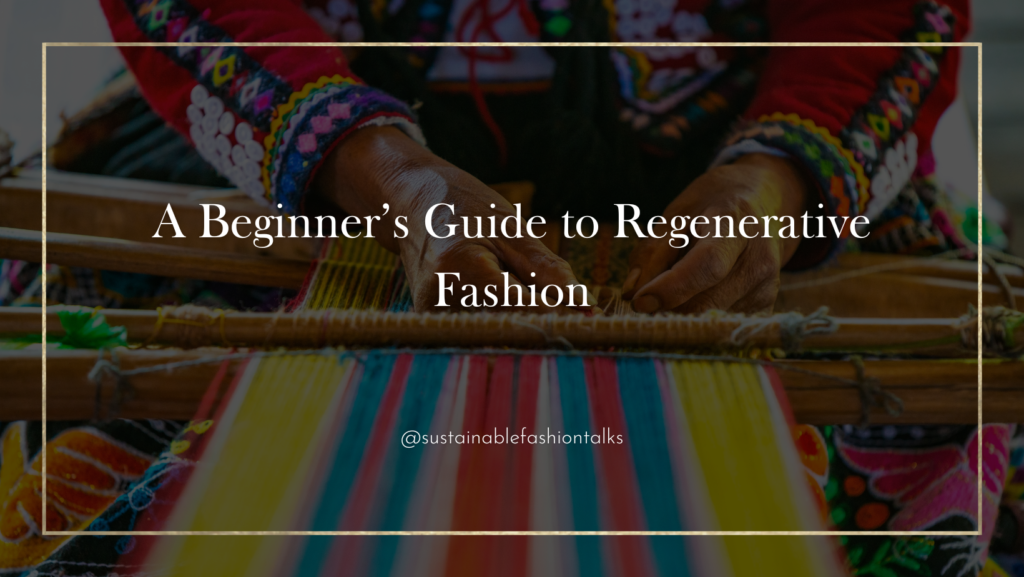Hello, dear readers! It’s Belinda here, the founder of Sustainable Fashion Talks. Two years ago, while diving into the depths of sustainable fashion, I stumbled upon the term “Regenerative Fashion” courtesy of Dominique Drakeford. This concept is part of a journey of discovery that I’m still on today, exploring the depths of sustainability and its many facets. Now, I’m here to share what I’ve learned so far about Regenerative Fashion and how you can begin understanding this approach in case you are a complete beginner like I was.
Kindly note that this post is for beginners only. If you’re more advanced, feel free to skip to the advanced part of the post resources or share your helpful input in the comment box below to help others on this journey!
What is Regenerative Fashion?
What I have come to understand is at its core, regenerative fashion goes beyond sustainability. While traditional sustainable practices aim to reduce harm to the environment, regenerative fashion seeks to restore and renew ecosystems, people, and communities involved in the fashion supply chain. It’s about creating a positive environmental impact rather than just mitigating a negative one.
Step 1: Grasping the Basics
To kick-start my learning journey into regenerative fashion, I knew that it was essential to listen as a dummy amidst anyone who spoke about regenerative fashion or regenerative agriculture without shame or fear of coming appearing as someone who was clueless. This made me realise that there are a few important principles:
- Regenerative Agriculture: The foundation of regenerative fashion, focusing on farming practices that restore soil health, increase biodiversity, and improve the water cycle. You can start exploring the basics by going through articles on this topic on platforms like Regeneration International.
- Circular Economy: This involves designing out waste and pollution, keeping products and materials in use, and regenerating natural systems. The Ellen MacArthur Foundation offers beginner-friendly explanations and resources.
- Ethical Production: Prioritizing fair labor practices and ensuring workers’ well-being throughout the supply chain. I personally used Fashion Revolution as a starting point to learn more about ethics in fashion.
Step 2: Engage with Educational Resources
The internet is filled with resources ranging from beginner to advanced levels. I once posted an instagram story saying “Hey fam, think of me as the dumbest person trying to learn about regenerative fashion and send me any useful resources.” The response was overwhelming with positive feedback and helpful links. People I look up to reached out to me with the aim of helping me understand. Here are some handpicked recommendations that guided me through my learning journey:
Beginner Level:
- FutureLearn: Fashion’s Future and the Sustainable Development Goals:A free online course that introduces sustainability in fashion and ties it to global goals.
- Good On You: A platform that rates brands based on their environmental and social impacts, helping you make more conscious fashion choices.
Intermediate Level:
- Coursera: Sustainable Fashion:While not entirely focused on regenerative fashion, these courses cover essential sustainability topics.
- Wardrobe Crisis Podcast: Hosted by Clare Press, this podcast covers in-depth discussions about the sustainable and regenerative fashion movement.
Advanced Level:
- Google Scholar: Search for scholarly articles on regenerative fashion and agriculture to dive deep into research and case studies.
- The Sustainable Fashion Academy:Offers webinars and advanced courses that delve into complex strategies and innovations in the sector.
Step 3: Connect and Engage with the Community
One of the most powerful ways to learn is by connecting with like-minded individuals and experts in the field. Engage with the regenerative fashion community through:
- Social Media: Follow thought leaders like Dominique Drakeford, Leah Thomas (Green Girl Leah), and platforms like Remake.
- Online Forums and Groups:Participate in discussions on Reddit (e.g., r/sustainability) and Facebook groups dedicated to ethical fashion and sustainability.
Step 4: Start Small and Build Momentum
Regenerative fashion and sustainable fashion in general can feel overwhelming at first especially because there are people always on standby to point out what you are doing wrong, but remember, every small step counts. Soround yourself with positive people who will help you grow. Here are some actionable tips to get started today:
- Purchase Mindfully: Choose brands that prioritize regenerative practices. Use apps like Good On You to identify these brands.
- Support Local Artisans: Often, small-scale and local producers use more regenerative methods. I personally support any brand globally that focuses on ethical fashion because I am a big traveller and I love supporting local communities wherever I go.
- Educate Yourself Continuously: Make a habit of reading articles, listening to podcasts, and taking courses regularly.
Final Thoughts
My journey into sustainable fashion and responsible travel has been nothing short of enlightening, and I hope this guide serves as a helpful starting point for your regenerative fashion journey.
As I always say, we’re all learning and evolving together. Let’s embrace the imperfections, support each other instead of pointing out our failures, and strive for a fashion industry that not only sustains but heals our planet.
If you have any questions or want to share your own discoveries, please leave a comment below or connect with us on social media. No one adopts a fully sustainable lifestyle overnight. Together, we can make a difference!
Stay blessed,
Belinda.
#Resources:
- Regeneration International:www.regenerationinternational.org
- Ellen MacArthur Foundation:www.ellenmacarthurfoundation.org
- Fashion Revolution:www.fashionrevolution.org
- FutureLearn:www.futurelearn.com
- Good On You:www.goodonyou.eco
- Coursera:www.coursera.org
- Wardrobe Crisis Podcast:www.clarepress.com/wardrobe-crisis-podcast
- Google Scholar: scholar.google.com
- Sustainable Fashion Academy:www.sustainablefashionacademy.org
- Remake:www.remake.world
